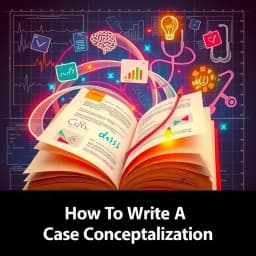
How to Write a Case Conceptualization
Find this useful? Bookmark ( CTRL/CMD + D ) for quick access!
Try an example:
Clinical Case Analysis
Therapeutic Intervention Planning
Client Progress Evaluation
Crisis Management Strategy
Diagnostic Assessment Framework
Treatment Outcome Prediction
Explore Similar Tools
Recent Generations
the amount paid directly to you. Yes it is possible in future cases to request direct payment to the provider, Rephrase and give me polished email.
we have processed the claim as per the attachments in the claim submission we have processedthe invoice for Saul Holding. We dont have invoice for the Salofalk.
this additional information is very important. this adiitional information was requested by our clinical team. Without clinical review claim not be paid so please share the below additional information
How To Write A Case Conceptualization
How To Write A Case Conceptualization is a powerful AI-powered writing tool that helps users create comprehensive and insightful case conceptualizations. This innovative solution combines advanced natural language processing with user-friendly templates to deliver high-quality, structured case analyses that meet professional standards.
Key Capabilities
- Automated Structure Generation: Quickly generates a well-organized framework for case conceptualizations, ensuring all critical components are included.
- Customizable Templates: Offers a variety of templates tailored to different therapeutic approaches, enabling users to personalize their case conceptualizations effectively.
- Real-Time Feedback: Provides instant suggestions and improvements, helping users refine their writing and enhance clarity and coherence.
- Research Integration: Seamlessly incorporates relevant research and evidence-based practices, ensuring that your case conceptualizations are grounded in the latest psychological theories.
Who It's For
Designed for mental health professionals, students, and educators, How To Write A Case Conceptualization excels in academic and clinical settings. Whether you're a therapist preparing for a client session or a student working on a case study, this tool streamlines your workflow and enhances productivity.
Why Choose How To Write A Case Conceptualization
What sets How To Write A Case Conceptualization apart is its ability to blend AI-driven insights with practical writing support, making it the ideal solution for anyone looking to improve their case conceptualization skills.
Ready to transform your case writing process? Start using How To Write A Case Conceptualization today and experience the difference in your professional practice!
Enhance Your Work with How to Write a Case Conceptualization
Leverage the power of AI to streamline your tasks with our How to Write a Case Conceptualization tool.
Structured Framework
Utilize a clear and organized framework for case conceptualization, ensuring all critical elements are addressed.
Client-Centered Approach
Focus on the unique needs and perspectives of clients, enhancing the relevance and effectiveness of the case conceptualization.
Comprehensive Templates
Access a variety of customizable templates to streamline the case conceptualization process and improve consistency.
How How to Write a Case Conceptualization Works
Discover the simple process of using How to Write a Case Conceptualization to improve your workflow:
Gather Case Information
Collect all relevant information about the case, including client history, presenting issues, and any previous interventions.
Identify Key Themes
Analyze the gathered information to identify key themes and patterns that will inform the conceptualization.
Develop Conceptual Framework
Create a conceptual framework that integrates the identified themes and provides a comprehensive understanding of the case.
Finalize and Review
Review the case conceptualization for clarity and coherence, ensuring it aligns with therapeutic goals and interventions.
Use Cases of
How to Write a Case Conceptualization
Explore the various applications of How to Write a Case Conceptualization in different scenarios:
Clinical Case Formulation
Assist mental health professionals in developing comprehensive case conceptualizations for clients, integrating clinical history, presenting problems, and treatment goals.
Educational Assessment
Support educators in creating detailed case conceptualizations for students with learning difficulties, outlining strengths, challenges, and tailored intervention strategies.
Social Work Case Management
Aid social workers in formulating case conceptualizations that encompass client backgrounds, social dynamics, and resource needs to enhance service delivery.
Research and Academic Writing
Facilitate researchers and students in writing case conceptualizations for academic papers, ensuring clarity in problem identification, theoretical frameworks, and implications for practice.
Who Benefits from How to Write a Case Conceptualization?
AI-Powered Efficiency
From individuals to large organizations, see who can leverage How to Write a Case Conceptualization for improved productivity:
Mental Health Professionals
Enhance client assessments and treatment planning through structured case conceptualizations.
Students in Psychology
Develop essential skills in case conceptualization for academic and practical applications.
Clinical Supervisors
Provide effective guidance and feedback to trainees on their case conceptualization skills.
Research Scholars
Utilize structured case conceptualizations to inform research studies and theoretical frameworks.
Frequently Asked Questions
What is a case conceptualization?
A case conceptualization is a comprehensive understanding of a client's issues, including their history, presenting problems, and the factors influencing their behavior. It serves as a foundation for treatment planning.
How does the AI tool assist in writing a case conceptualization?
The AI tool provides structured templates, prompts, and examples to guide users in creating detailed and coherent case conceptualizations. It helps streamline the writing process and ensures important elements are included.
Is the AI tool suitable for beginners in mental health?
Yes, the tool is designed to be user-friendly and accessible for both beginners and experienced professionals. It offers guidance and resources to help users at all levels effectively write case conceptualizations.
Can I customize the case conceptualization templates?
Absolutely! The AI tool allows users to customize templates according to their specific needs and preferences, ensuring that the final output aligns with their unique approach to case conceptualization.
Is there a support system available if I encounter issues while using the tool?
Yes, we provide comprehensive customer support, including tutorials, FAQs, and direct assistance from our support team to help you resolve any issues or questions you may have while using the tool.
































